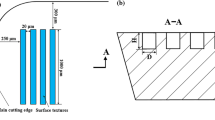Abstract
The CFRP drilling process has not yet been fully mastered, which is due to the fact that it is not possible to measure all the cutting force components. In order to gain new insights into the drilling process, a novel experimental setup is being developed in order to record all cutting force components (cutting force, feed force, passive force). The results show that the force components are strongly dependent on the fiber cutting angle θ and the wear condition. Thereby, it will be possible to draw conclusions about the cutting mechanics in the drilling of unidirectional CFRP based on the transformation of the forces perpendicular and parallel to the fiber.
















Similar content being viewed by others
References
Abrao AM, Faria PE, Campos Rubio JC, Reis P, Davim JP (2007) Drilling of fiber reinforced plastics: a review. J Mater Process Technol 186(1–3):1–7
Davim JP (2009) Drilling of composite materials. Nova Science Publishers, New York
König W, Wulf C, Grab P, Willerscheid H (1985) Machining of fibre reinforced plastics. CIRP Ann Manuf Technol 34(2):537–547
Schütte C (2014) Bohren und Hobeln von kohlenstofffaserverstärkten Kunststoffen unter besonderer Berücksichtigung der Schneide-Faser-Lage. Dissertation TU-Hamburg-Harburg
Lopresto V, Santo L, Caprino G, De Iorio I (2001) Mechanisms of chip generation in orthogonal machining of unidirectional carbon fibre reinforced plastics. In: Proceedings PRIME, Sestri Levante Italy 20.–22. June, pp 81–86
Wang DH, Ramulu M, Arola D (1995) Orthogonal cutting mechanisms of graphite/epoxy composite. Part I: unidirectional laminate. Int J Mach Tools Manuf 35(12):1623–1638
Wang XM, Zhang LC (2003) An experimental investigation into the orthogonal cutting of uni-directional fibre reinforced plastics. Int J Mach Tools Manuf 43(10):1015–1022
Zhang LC, Zhang HJ, Wang XM (2001) A force prediction model for cutting unidirectional fibre-reinforced plastics. Mach Sci Technol 5(3):293–305
Rummenhöller S (1996) Werkstofforientierte Prozessauslegung für das Fräsen kohlenstofffaserverstärkter Kunststoffe. Dissertation RWTH Aachen
Hintze W, Clausen R, Hartmann D, Kindler J, Santos S, Schwerdt M (2007) Precision of machined CFRP—The challenge of dimensional accuracy. In: Proceedings of the 1st international workshop on aircraft system technologies, Shaker Aachen
Hocheng H, Dharan CKH (1990) Delamination during drilling in composite laminates. ASME J Eng Ind 112(3):236–239
Hocheng H, Tsao CC (2003) Comprehensive analysis of delamination in drilling composite materials with various drill bits. J Mater Process Technol 140(1–3):335–339
Di Ilio A, Paoletti A, Veniali F (1996) Tool wear in drilling thermoset and thermoplastic matrix composites. ASME Eng Syst Design Anal 3:41–46
Faraz A, Biermann D, Weinert K (2009) Cutting edge rounding: an innovative tool wear criterion in drilling CFRP composite laminates. Int J Mach Tools Manuf 49:1185–1196
Iliescu D, Gehin D, Nouari M, Girot F (2006) Impact of a diamond coating on tool wear behaviour during dry machining of a multidirectional composite material. Journal de Physique IV France 134:1201–1206
Iliescu D, Gehin D, Gutierrez ME, Girot F (2010) Modeling and tool wear in drilling of CFRP. Int J Mach Tools Manuf 50(2):204–213
Karpat Y, Camuscu N, Kilic A, Sonat F, Deger B, Bahtiyar O (2010) Drilling carbon fiber reinforced plastics with diamond coated carbide cutting tools. In: Proceedings of the 36th international MATADOR conference, pp 205–208
Toho Tenax Europe GmbH. Product information carbon fibres. http://www.tohotenax-eu.com. 16 Jul 2013. 01:00 p.m.
Cytec Industries Inc. Product information CFRP. http://www.cytec.com. 16 Jul 2013. 02:35 p.m.
Hexcel Corporation. Product information CFRP. http://www.hexcel.com. 16 Jul 2013. 10:30 a.m.
Hintze W, Hartmann D (2013) Modeling of delamination during milling of unidirectional CFRP. In: 14th CIRP conference on modeling of machining operations (CIRP CMMO). Procedia CIRP, vol 8, pp 444–449
Henerichs M, Voß R, Kuster F, Wegener K (2014) Charakterisierung der Schneidkantengeometrie für Standzeitoptimierung beim Bohren von CFK. Diam Bus 3:42–53
Kindler J (2010) Werkstückqualität und Standzeitoptimierung von Zerspanwerkzeugen bei der Umrissbearbeitung von kohlenstofffaserverstärkten Kunststoffen. Dissertation TU-Hamburg-Harburg
Author information
Authors and Affiliations
Corresponding author
Rights and permissions
About this article
Cite this article
Hintze, W., Clausen, R., Schütte, C. et al. Evaluation of the total cutting force in drilling of CFRP: a novel experimental method for the analysis of the cutting mechanism. Prod. Eng. Res. Devel. 12, 431–440 (2018). https://doi.org/10.1007/s11740-018-0807-2
Received:
Accepted:
Published:
Issue Date:
DOI: https://doi.org/10.1007/s11740-018-0807-2




